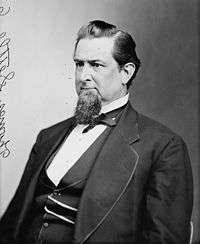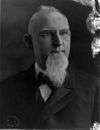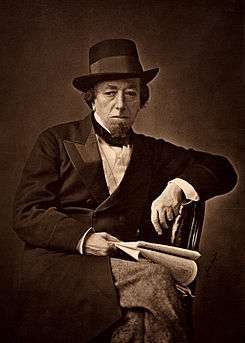Goatee

A goatee is a style of facial hair incorporating hair on a man's chin but not his cheeks. The exact nature of the style has varied according to time and culture.
Description
Until the late 20th century, the term goatee was used to refer solely to a beard formed by a tuft of hair on the chin—as on the chin of a goat, hence the term 'goatee'.[1] By the 1990s, the word had become an umbrella term used to refer to any facial hair style incorporating hair on the chin but not the cheeks; [2] there is debate over whether this style is correctly called a goatee or a Van Dyke.[3]
History
The style dates back to Ancient Greece and Ancient Rome, where the god Pan was traditionally depicted with one. When Christianity became the dominant religion and began coopting imagery from pagan myth, Satan was given the likeness of Pan, leading to Satan traditionally being depicted with a goatee in medieval and renaissance art.
The goatee became popular again in the late 19th century, becoming one of the characterizing physical traits of the bohemians in Paris. In the U.S., the style became popular around the time of the American Civil War. Numerous wartime figures from the era wore variations on the goatee, including Abraham Lincoln, who shaved his beard into a traditional goatee at various points during his presidency.
The goatee would not enjoy widespread popularity again until the 1940s, when it became a defining trait of the beatniks in post-World War II U.S. The style remained popular amongst the counter culture until the 1960s before falling out of favor again. In the 1990s, goatees with incorporated mustaches became fashionable for men across all socioeconomic classes and professions, and have remained popular into the 2010s.
In popular culture
In the media, goatees have often been used to designate an evil or morally questionable character; the convention has most consistently been applied in media depicting evil twins, with a goatee often being the sole physical difference between the twins.[4] Goatees have also been used to signify a character's transformation from positive or neutral to evil. The use of goatees to designate evil characters has become enough of a trope that researchers from the University of Warwick conducted a study to assess the reasons for its prevalence. The study found that the human brain tends to perceive of downwards-facing triangles as inherently threatening; brains tend to perceive of goatees as making the human face resemble a downwards-facing triangle, causing individuals to subconsciously perceive of those with goatees as inherently sinister or threatening.[4]
In media depicting members of counter-cultures, goatees have also been used to differentiate between average characters and those belonging to some subgroup. Examples include Bob Denver in The Many Loves of Dobie Gillis, whose goatee serves to identify him as a beatnik; Shaggy Rogers in Scooby Doo, Where Are You?, who is, in part, identified as a hippie by his goatee; and the DC Comics superhero Green Arrow, who was visually redesigned with such a beard in the late 1960s, inspiring writer Dennis O'Neil to re-imagine him as a politically active counter-culture hero.
Famous people who sported goatees
- Darrell Abbott
- Buffalo Bill
- August Borms
- Thomas H. Carter
- Charles I of Great Britain
- Kurt Cobain
- Charles Dickens
- Benjamin Disraeli
- Guy Fawkes
- Guy Fieri
- Rob Halford
- James Hetfield
- David Hilbert
- Henry M. Hoyt
- Scott Ian
- Jesse James
- James I of Great Britain
- Kerry King
- Anton Szandor LaVey
- Vladimir Lenin
- Abraham Lincoln
- Cesare Lombroso
- Louis XIII of France
- Georges Méliès
- Hồ Chí Minh
- Napoleon III
- Raymond Poincaré
- Cardinal Richelieu
- Peter Paul Rubens
- Colonel Sanders
- Erik Satie
- Thomas Settle
- Tupac Shakur
- Layne Staley
- Serj Tankian
- Tech N9ne
- Rip Torn
- Carlo Tresca
- Walter Ulbricht
- The Undertaker
- Antoon van Dyck
Famous fictional characters who sport goatees
- Ali G.
- David Brent
- Professor Calculus
- Flexo, Bender's evil twin.
- Oliver Queen, the Green Arrow
- Iroh sported a goatee and dramatic sideburns during the first season of Avatar: The Last Airbender
- Iznogoud
- Jafar
- Koziolek Matolek
- Krimson
- Pan
- Shaggy Rogers
- Joachim Sickbock, an anthropomorphic goat in Tom Poes
- Lance Spearman
- Uncle Sam
- Spock from the Mirror Universe
- The Master in pre-hiatus Doctor Who
- Tony Stark
- Benjamin Sisko
- Walter White
- Chandler Bing
- Flynn Rider
Gallery
| Wikimedia Commons has media related to Goatee. |
- A Moai kavakava from Easter Island. Many statues from Easter Island have goatee beards.
- Painting of Pan by Arnold Böcklin (1864–65)
 Henry M. Hoyt (c. 1865–80)
Henry M. Hoyt (c. 1865–80) Thomas Settle (c. 1865–80)
Thomas Settle (c. 1865–80) William H. Hunt (c. 1865–80)
William H. Hunt (c. 1865–80) Thomas Henry Carter (1909)
Thomas Henry Carter (1909) Benjamin Disraeli (1878)
Benjamin Disraeli (1878).jpg) Uncle Sam poster (1916)
Uncle Sam poster (1916)_Dzier%C5%BCek.jpg) Tomasz "Dzierżu" Dzierżek (2007)
Tomasz "Dzierżu" Dzierżek (2007) Tota Komizu (2011)
Tota Komizu (2011)
See also
| Look up goatee in Wiktionary, the free dictionary. |
References
- ↑ "goatee". Oxford English Dictionary. Retrieved 2011-12-20.
- ↑ Howard, Rebecca (10 September 1992). "Year of the Goat: Goatee is kicking again". The Globe and Mail.
- ↑ Shrieves, Linda (12 November 1993). "Goatees, the new hair apparent". The Buffalo News.
- 1 2 "Scientists Prove that a Goatee Makes you Look Evil". i09.com. Retrieved 1 June 2012.